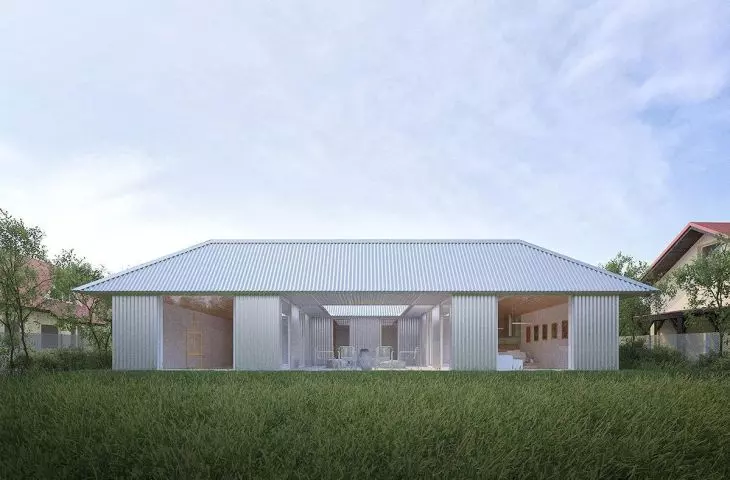The unusual single-family house under construction in Tryszczyn near Bydgoszcz, because it is "wrapped" in galvanized corrugated sheet metal, is a project and a private home by one of the architects from the AKKT studio. Its closed form and functional layout are due to the limitations of the plot, surrounded by public roads and dense buildings - so the priority was to ensure maximum privacy.
The closed form of the house is intended to provide maximum privacy
© AKKT
The designed single-story house is a non-basement building on a U-plan with a centrally located atrium with a hearth connected to the garden through a covered terrace. The functional program of the house has been clearly divided into three zones. The west wing is the living area, the middle is the night zone, while the entire east wing of the house is the studio - a multifunctional space that will be used according to the owner's needs. As the architects say, the multifunctional space is also a buffer, which, if necessary, will be easily adapted for living quarters, without enlarging the body of the building, which is a closed, finished composition.
The U-plan body of the building is a closed, finished composition
© AKKT
sincere architecture
The architecture of the house does not refer to the context, i.e. typical suburban buildings in most catalogs. In terms of aesthetics, we allowed the lump of the building to result directly from the site conditions, juxtaposed with the needs of the investor, it was in our power only to "wrap" it in "skin". We used galvanized sheet metal with a corrugated profile. Some of the sheet metal has perforations, thus revealing the glazing hidden under the steel shell. The building may seem a bit eccentric. On the other hand, we prefer to think that it is simply sincere. It is a pure form, based on the simplest and optimal functional layout. For the finishing, we used several materials, in their most natural, raw appearance," the architects conclude.
The front façade gives the impression of being uniform,
however, windows covered with perforated metal sheets were used on fragments
© AKKT
The building was designed to be economical and ecological, both in construction and in use, relying on simple construction and high-quality materials. Cost optimization was made possible, among other things, by detailed planning of construction phasing, already in the concept phase. When designing the house, the architects took into account the life cycle of the building. The structural walls are exterior walls, so it is possible to change the layout of the rooms.
The west wing is the living area, the middle is the night zone,
while the entire east wing of the house is the studio
© AKKT
interview with Adam Kozlowski
Dobrawa Bies: How did you come up with this choice of materials and textures? Won't the galvanized sheet metal covering cause the building to overheat too much?
Adam Kozlowski: The use of such, and not other, materials and textures was an aesthetic choice, influenced by many factors. One of them was certainly the subconscious inspiration of the architectural work we admired, including contemporary Japanese residential architecture. Above all, however, what characterizes all of our projects - a love of material honesty. We believe that progressive material imitation in construction is absolutely the wrong direction. Besides, we never view a given material through the prism of associations or prejudices. We try to see only the physical characteristics of a given material, abstracting from cultural considerations. As for the risk of the building overheating. There is no such concern. The building envelope is properly insulated, and the only glazing on the south side is obscured by sheets of perforated metal.
A considerable design challenge was the location of the plot, placed between two roads
© AKKT
Dobrawa: The biggest challenge and the biggest source of pride was?
Adam: The biggest problem was the location of the plot, sandwiched between two roads and neighboring, taller buildings. Therefore, we consider it a success that we managed to create a space characterized by a sense of privacy, even though all the main rooms in the house have direct access to the outside. The heart of the house has become the courtyard, which is like a second living room.
For the interior finishes, the architects used several materials, at their most natural, raw
© AKKT
Dobrawa: Is designing for yourself more difficult than designing for a commission?
Adam: It turns out that they didn't. Mainly because when working with a client, often the most labor-intensive task is to convince the investor of the right solutions with which he is ultimately most satisfied. The process of designing for ourselves is so much more comfortable that this most thankless stage of work does not occur. We verified the design among ourselves, in the studio, and here we understand each other very well.
Dobrawa: Thank you for the interview.












































